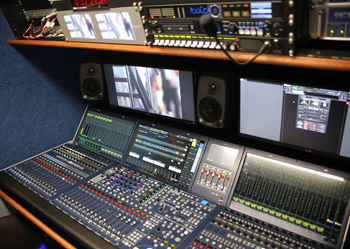World Cup 4K Matches Sound Good With Lawo
GloboSat's new TV 4K-capable OB truck is getting a workout in Brazil, producing live broadcasts from World Cup matches played in the Maracana stadium, in Rio de Janeiro. The vehicle, which was completed just in time for this year's event, is Brazil's first 4k OB truck, and is fitted with audio equipment from Lawo and state-of-the-art Ravenna open source audio-over-IP networking technology.

The surround sound audio for three 4K productions will be mixed on board GloboSat's new 4K truck with a Lawo mc²56 digital mixing console. Utilizing standardized network protocols and technologies, the all-industry Ravenna initiative is designed to meet the challenges of real-time transport of audio and other metadata in IP-based production environments.
The GloboSat truck is using 12 Sony CineAlta PMW-F55 4K cameras (with Fujinon lenses) and a Sony MVS7000x production switcher (with 4K upgrade and set up as a 20-input switcher) to shoot and produce three matches in 3840 x 2160 resolution for broadcast (a Round of 16 match on June 28, a quarterfinal match on July 4 and the Final on July 13). More than a dozen international broadcasters have agreed to broadcast the 4K feed, including the BBC in the UK and TV Globo in Brazil.
At the heart of the truck's audio control room is a 48-fader Lawo mc²56 digital mixing console, which is tightly integrated with other equipment on the truck via a Dallis I/O system in the truck and two Dallis stageboxes (with port redundancy) that are linked to the Ravenna network. The console's integrated Lawo Plugin Server allows seamless integration of plugin effects that can be easily recalled with pre-stored snapshots.
"We have had good results with audio-over-IP for some time, but we now face the requirement for a higher channel count and infrastructure growth," said Gabriel Thomazini, sound engineer in Rio on the GloboSat OB truck. "We are ready for this next level of challenge with Ravenna /AES67 and the Lawo mc² series. For us, Lawo represents an ideal balance between technology and functionality for a complex event like the World Cup."
The Maracana stadium was built for the world championships in 1950, and was then the world's largest stadium providing space for 200,000 visitors. It has since been rebuilt several times, including being updated for the 2014 World Cup tournament, now seating around 78,000 people. The venue, following the group matches, will host the quarterfinals and the final match of the World Cup, as well as the tournament closing ceremony. All will be broadcast with Lawo sound and Ravenna technology.
The professional video industry's #1 source for news, trends and product and tech information. Sign up below.
